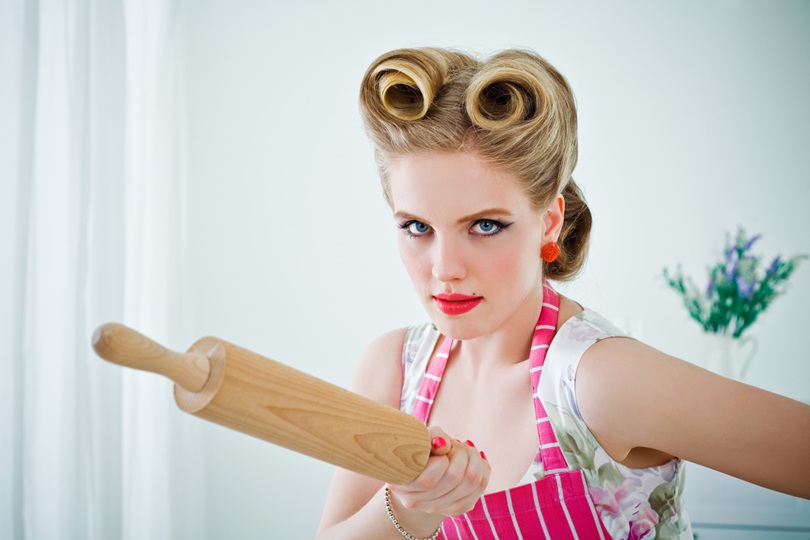Why Do I Wish I Was a TradWife?

I don’t own an apron. I made on in Home Ec. in Grade 8. It was burgundy with white lace trim. I sewed the whole thing by hand because I could not figure out how to work the bobbin on the sewing machine. I feel this automatically primed me as total TradWife material. Now technically I’m no longer even a wife and I still think I want to be a TradWife.
If you’re scrolling Instagram or TikTok you may have stumbled into this unexpectedly soothing corner of the internet. Women in floral aprons are gracefully preparing homemade bread. Children are quietly crafting at the kitchen table. There are soft filters, piano music, and one common theme: “I’m a TradWife.”
What Even Is a TradWife?
Short for “Traditional Wife,” the TradWife trend romanticizes 1950s-style domesticity, complete with stay-at-home mothering, homemaking as a calling, and a husband who leads the household. At first glance, it seems wholesome. Sometimes? It even looks… appealing.
As a mom who spent years and years juggling career, household, and parenting, I kind of understand the allure. For me it’s not about being submissive. I feel like so long as the TradHusband is holding up his end of the deal, the notion of structure and clarity that comes along in a “traditional” household is really, really appealing. And that’s where things get tricky.
What Is the TradWife Lifestyle?
The TradWife lifestyle is not new, but it’s currently having a social media renaissance. Young, articulate, and media-savvy influencers share dreamy glimpses of their lives that are built around home and family. Some, like viral TikToker Alexia Delarosa, openly describe “submission” to their husbands as an act of strength and devotion.
In Canada, the trend has gained some traction too. Take a quick scroll through hashtags like #TradWifeCanada and there are content creators showcasing breadmaking, homeschooling, and religious teachings, all under the umbrella of “feminine empowerment.”
But the empowerment can be complicated. When does it cross into control?
The TradWife Slide into Coercion
Once upon a time, my family embodied incredibly traditional gender roles, and I was fine with that. So it’s important to differentiate between choosing a traditional role and being pressured into one. Coercive control is a form of emotional abuse that doesn’t always show up as shouting or name-calling. Coercive control can manifest through subtle restrictions on finances, appearance, friendships, or independence.
And the Government of Canada has recognized coercive control as a serious risk factor in domestic abuse cases. As of 2019, Canada’s Divorce Act includes patterns of control and manipulation when assessing the best interests of children in custody decisions.
So when a woman says she doesn’t “argue” with her husband, or that he “lets” her stay home, we have to ask: Is this a dream she chose, or a dynamic she’s stuck in?
What’s the Appeal of Being a TradWife?
There’s a reason the TradWife trend is taking off. Mothers today are burnt out. The promise of staying home to care for children and make a beautiful life—without the constant pull of career ambition and the ever-elusive “work-life balance.”
And it’s not inherently bad. Wanting to be home with your kids and loving domestic life is not a betrayal of feminism. Feminism is about choice. The trouble comes when women are taught that the only “good” choice is the one that keeps them quiet, obedient, and dependent.
What a Healthy TradWife Life Might Look Like
If I’m being honest, I could imagine embracing a TradWife-lite life… so long as that trade-off included a supportive, present, and responsible partner. A spouse who viewed household management as a shared enterprise, not a gendered birthright. A spouse who didn’t expect obedience, but offered partnership.
The issue isn’t aprons. It’s power.
What a TradHousehold Teaches Our Daughters (and Sons)
Ultimately it’s not about whether a woman bakes bread or builds a business. It’s about whether she can do either without fear, shame, or restriction. As mothers, we must model relationships that are built on mutual respect, shared responsibility, and genuine choice.
The TradWife trend might look soft and sweet. It looks comfortable. So it’s essential to understand what’s really underneath the aesthetic. Because if it’s expected or enforced submission, it’s suppression.















